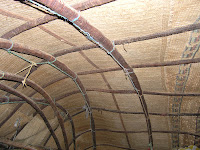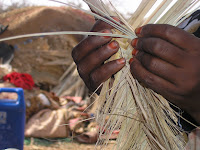Construction of a Somali hut
This, above, is the Somali hut being constructed - and as I mentioned before, you’d notice that it is only women who build the huts. The men usually gather the wood from the Galool, Gob, Dhumay trees etc, and then the women get to work. The above hut being constructed is called Saddex-dhigood, meaning it is made out of three arched Gob branches as you can see above. This is the smallest hut constructed and the largest is made out of seven. The most common huts though are made out of either three or four Dhigood (arched branches).


Though not of the same hut, this is how the inside of some huts looks like. In this picture, the thin branches that run somewhat perpendicular to the three Dhigo, along the entire hut, are called lool. These lool form a spread above the Dhigo so that the woven mats can be fastened onto the hut.


And this is how the mats are then fastened to the hut. What you see in the picture on the left is called Udub-Dhexaad - the middle, or sometimes on either sides of the hut, wood made usually out of Dayyib tree that fortifies the hut and keeps it erect.
And this is how the inside looks like when it is finally built, with a small branch for hanging clothes as an extra (left).
Now that the hut is almost complete with all the pillars of wood erected and the hut standing firmly, the only thing left to do is fasten the skilfully woven mats onto the pillars wood. The mats are made from something called Caw (above left) and have to be made by hand. First the Caw is gathered from the woodland after days of scouting, then after getting rid of the impurities, it is assembled as above and the interlacing or plaiting of the Caw begins (above right). This process of interlacing the Caw is called Falag and is usually done over drinks when women gather for conversations late in the afternoon.


After interlacing the Caw, a single long sheet of Caw is made. This sheet is called Gadaan (above left). The name is derived from the meaning of the word Gadaan which means “round” - and because the Caw, after each plait, is rounded up as in the above picture, it is given such a name. Hundreds of single plaits of Caw are then interwoven to form a large mat called Dermo (Plural - Dermooyin). The picture on the right shows the Dermooyin on top of the hut.

And here is the final result… As for the time it takes - well I passed by the hut being built (top) on my way to a place called Ceelbuh. By the time I came back, about and hour and a half later, the hut was completed! In whatever way it is made, the intricacy and magnificence of the Somali Aqal is a testament to the ingenuity and handicraft of the Somali nomads, or Somali women I should say. The huts are made entirely by young girls and their mothers and the involvement of a man is very little, limited to just collecting the wood needed for the construction. For their mats, the Somali women still weave brilliant artefacts dating back to the early times of nomadic life. The learning process of making Aqal Soomaali (Somali hut) is passed down from generation to generation, from mother to daughter and sleeping inside one of these huts is a truly wonderful experience. Kudos to the female Somali nomads!
Labels: Cultural heritage, Nomadic Life, Somali Nomads, Somali traditions, Somali women
posted by Shafi @ 10:00 AM
![]()








0 Comments:
Post a Comment
<< Home